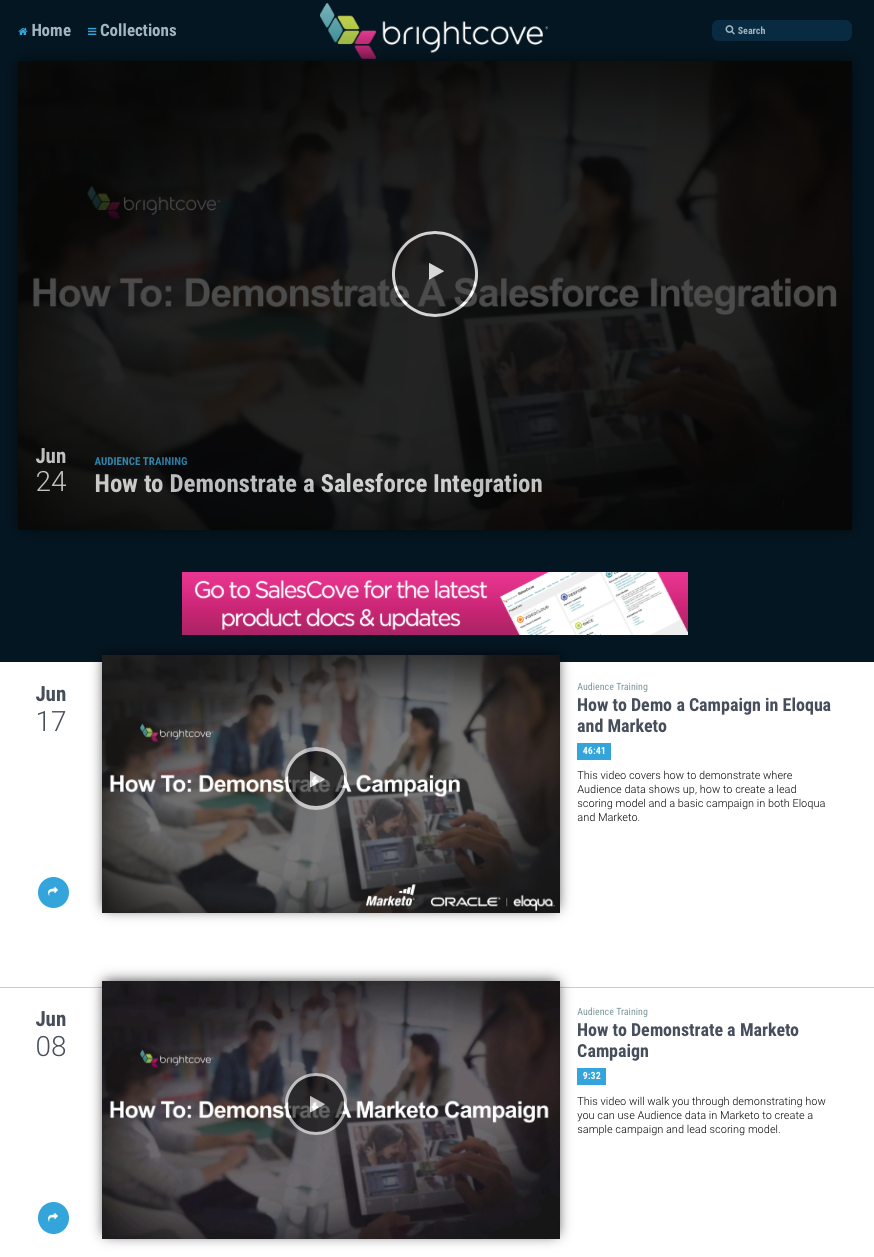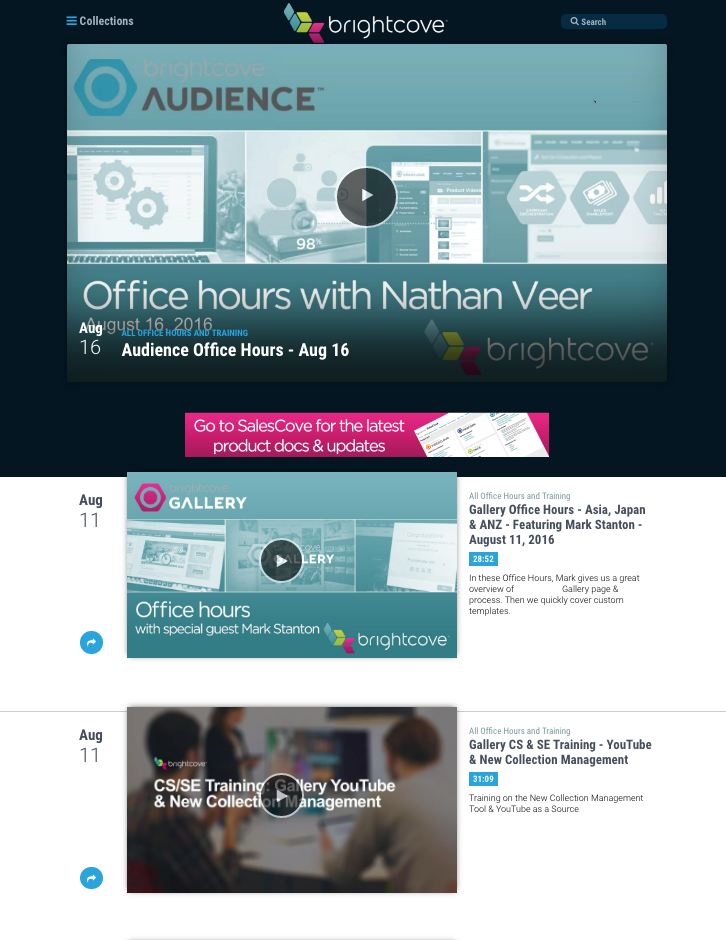Brightcove is a global business with 12 offices worldwide. Our sales and marketing teams span time zones and continents. Trying to schedule a live meeting that can accommodate everyone is a challenge, so imagine pushing out vital information such as product updates and additional sales trainings effectively! To answer this problem, we turn to video. Two of our amazing product marketers, Nathan Veer and Lamia Chlala, record product updates and product-specific “office hours” with Q & A, placing them in a video gallery for on-demand training and knowledge sharing. Their technical know-how is matched by their creativity and the video program is a well-received by our global teams.
Don’t keep the expertise of your teams locked away. We all have an innate need to share, learn, and connect with others. Recognize that, in today’s high-efficiency, lean-staffed workplaces, every employee is a subject matter expert. This is certainly true at Brightcove where our digital marketing team has ZERO redundancies. Video empowers us to share our expertise between offices and teams. In an increasingly digital world are you ready to empower your teams’ communications through video?
The Benefits of Using Video for Knowledge Sharing
Improved learning: video created and shared by employees, for employees, is corporate education gold. Video can supplement trainings while adding variety and improving the audience’s ability to retain the information.
Reduced costs: large enterprises save immensely by shifting a portion of training to on-demand video.
Controlled internal messaging: leveraging video for internal knowledge sharing provides consistent learning experiences, ensuring everyone receives that critical information the same way, utilizing the same definitions and terms.
Empowered independent learning: shifting from a “push” model that requires trainers to present before a live audience to a “pull” model enables employees to search for what they need when they need it

A video portal created by product marketing for sales instructing how to demo our Audience integrations
Effective Video Types for Knowledge Sharing
Now that you’ve decided you’d like to give knowledge sharing through video a try, which kinds of videos should you create? Opportunities are all around you!
Product updates and training: record product information and demonstration videos to help develop a knowledgeable team. Try showing a product in action, out in the field, or stream demos from engineers and product managers.
Sales training: communicate corporate sales strategy, including tips for establishing relationships, demo-ing products, and closing deals.
Sales enablement: arm sales reps with best practices and up-to-date information by recording your sales strategy discussions and presentations. Consider filming a different sales leader each quarter Perhaps she could outline a challenging sale and what was done to overcome objections and win the account.
On-demand conference learnings: record presentations, meetings, and other activities from conferences that will accelerate knowledge sharing. By doing this you can send a few attendees but share information collectively across a larger group. Consider having employees present to others back at the office -- they’ll retain the information through teaching it while spreading lessons far and wide.
Coaching and professional development: train new managers and give them full exposure to the knowledge of the organization’s management team training via on-demand video training programs.

All “Office Hours” are recorded allowing sales to access training on product updates anytime, anywhere. Our marketers keep things fresh by inviting special guests to contribute their knowledge.
5 Tips for Creating a Better Video Knowledge Sharing Portal
You’ve unlocked knowledge by recording it, now you have to make sure it’s easily accessible to your employees and that your new corporate video gets buy-in across the organization.
Create a library: store institutional knowledge in a branded, business video portal with secure access. After uploading the video, tag videos with appropriate keywords and add text that describes each. This will make searching for resources easier.
Add transcripts and captions: beyond accessibility requirements which some companies may be subject to, adding a text-based companion to your video adds to learning. Reading while listening lifts retention but adding searchable, interactive transcripts, allows employees to search videos to find the information they want fast access to.
Reward participation: award incentives for those who regularly contribute to video knowledge sharing initiatives. Consider creating internal contests.
Gamify with interactive elements: introduce game mechanics into learning videos. For example, a compliance video might be made to “spot the problems.” Include interactive video elements like quizzes, polls or hot spots.
Provide a rating system: give employees the ability to review and/or rate the content.
Video has become an invaluable way to improve knowledge sharing across the enterprise. Instead of relying on just a few employees to deliver 100% of the training, now all employees can share their knowledge, enhancing your total workforce. If you’re ready to get started with an internal video program, consider the first themes or channels of content you’ll develop. Take a note from Nathan and Lamia -- to effectively share knowledge across your enterprise you need to think like a publisher or media producer and ask, how will I continue to deliver more videos in this genre/theme? Answering this will help you to generate ideas for additional video content and internal knowledge experts, just when you thought you ran out of topics! Plot a six-month production and release calendar to keep ahead of video consumption and then give your employees what they crave -- lessons from professionals they know and admire.
Check out some of Brightcove customer’s Gallery sites for additional inspiration:
HerbalifeAccuWeather
BassMasters
Omega Studio
Advantage Business Media

